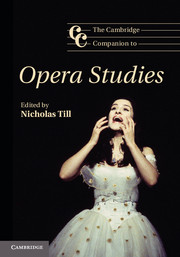Book contents
- Frontmatter
- Contents
- Contributors
- Acknowledgements
- Introduction: opera studies today
- Part One Institutions
- Part Two Constituents
- Part Three Forms
- 8 The dramaturgy of opera
- 9 Genre and poetics
- 10 The operatic work: texts, performances, receptions and repertories
- Part Four Issues
- Further reading
- Index
- References
8 - The dramaturgy of opera
from Part Three - Forms
Published online by Cambridge University Press: 05 December 2012
- Frontmatter
- Contents
- Contributors
- Acknowledgements
- Introduction: opera studies today
- Part One Institutions
- Part Two Constituents
- Part Three Forms
- 8 The dramaturgy of opera
- 9 Genre and poetics
- 10 The operatic work: texts, performances, receptions and repertories
- Part Four Issues
- Further reading
- Index
- References
Summary
Opera is a multivalent art form: it combines dramatic and literary traditions with vocal and instrumental music and the visual and plastic arts to tell a story. One recurring question in opera studies is exactly how do these diverse modes of expression interact with one another? In an art work that brings together multiple, and possibly competing, expressive ‘systems’ what creates structure and makes an opera cohere? Is the poetry the primary purveyor of narrative and form? Is the music the chief dramatic and structural agent? If so, do recurring melodies or tonalities take primacy in determining form? Or should we be concerned with formal coherence at all?
How critics and musicologists have answered the above questions – in fact, even the questions raised – depends upon which of opera’s domains has been given precedence and what analytical approach has been taken. At various points in opera studies’ history, incongruencies and frictions between expressive systems have been smoothed over in favour of demonstrating synthesis, tonal progressions have received more attention than texts, thematic relations across a work more priority than individual numbers. Which parameter has been used as a starting point has resulted in a number of seemingly conflicting, yet overlapping, findings to questions of form. In short, opera’s musico-dramatic structures stand in counterpoint to one another, a counterpoint that the field of opera studies itself reflects.
- Type
- Chapter
- Information
- The Cambridge Companion to Opera Studies , pp. 179 - 201Publisher: Cambridge University PressPrint publication year: 2012
References
- 3
- Cited by

